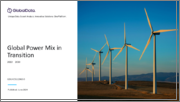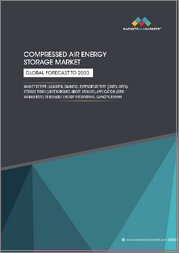
|
시장보고서
상품코드
1511546
세계의 에너지 전환에 따른 세계 전력 믹스(2022-2030년)Global Power Mix in Transition - 2022 -2030 |
||||||
전체적으로 2035년까지 전력 믹스는 크게 변화할 것으로 예상됩니다. 강력한 정책적 지원, 재정적 인센티브, 기술 향상으로 재생에너지의 경쟁력이 기존 화력발전에 비해 향상될 것입니다. 그 결과, 전력 믹스에서 재생에너지가 차지하는 비중은 2035년까지 49%를 나타낼 것으로 예상됩니다.
태양광 발전은 2035년 재생 가능 전력의 가장 큰 단일 전원으로 부상하여 2035년 전력 믹스의 20%를 차지할 것으로 예상됩니다. 그러나 풍력 발전도 성장하여 2023-2035년 해상 풍력 발전 부문의 CAGR은 18%를 나타낼 것으로 예상됩니다. 그러나 이러한 성장세에도 불구하고 2035년에는 화력 발전이 전체 발전량 구성의 42%를 차지할 것으로 예상됩니다.
경제가 화력 발전에서 탈피하는 속도는 지역마다 크게 다를 것으로 예상됩니다. 중남미는 2023-2035년 재생에너지 발전 비율을 70% 이상으로 유지하며 가장 깨끗한 지역 에너지 믹스를 유지할 것입니다. 유럽, 북미, 아시아태평양도 재생에너지 발전 비중이 크게 증가할 것으로 보입니다. 그러나 중동 및 아프리카는 2035년까지 화력발전에 대한 의존도가 여전히 높을 것으로 예상됩니다.
재생에너지의 채택은 수소와 에너지 저장과 같은 기술에 의해 촉진될 것입니다. 이 두 기술은 10년 말까지 강력한 성장세를 보일 것으로 예상되지만, 재생에너지 발전과 마찬가지로 시장 진입은 지역별로 크게 다를 것으로 예상됩니다.
이 보고서는 세계 전력 믹스에 대한 조사 및 분석을 통해 각 지역의 에너지 믹스, 각 전력 기술 동향 등의 정보를 제공합니다.
주요 하이라이트
- 기술 개발과 효율성 향상에도 불구하고 세계 에너지 수요는 2023-2035년간 연평균 3.4%의 성장세를 이어갈 것입니다.
- 세계 전력 믹스에서 재생에너지가 차지하는 비중은 지속적으로 증가하여 2023-2035년간 연평균 4.1%의 발전량 증가가 예상됩니다.
- 그러나 재생에너지 발전 증가에도 불구하고 석탄은 2035년까지 가장 지배적인 단일 에너지원으로 남아 전 세계 전력 믹스에서 21%의 점유율을 차지할 것으로 예상되며, 이는 태양광을 약간 상회하는 수치입니다.
- 아시아태평양의 발전량은 2023-2035년간 연평균 4.5%의 성장세를 보일 것으로 예상됩니다. 이 주요 요인은 인구 증가에 기인합니다.
- 태양열, 지열, 바이오 발전은 계속해서 kW당 프로젝트 비용이 가장 높은 부류에 속합니다.
- 2027년에 천연가스 발전 용량이 가장 많이 증가할 것으로 예상되며, 이 해에 106GW의 발전 용량이 추가될 것으로 예상됩니다.
목차
전력 믹스 전환
- 거시 지표
- 발전 점유율 : 지역별
- 세계의 전력 믹스
지역별 에너지 믹스
- 아시아태평양
- 유럽
- 중동 및 아프리카
- 북미
- 중남미
전력별 기술 동향
- 태양
- 풍력
- 수력
- 바이오발전
- 지열
- 핵
- 열
- 에너지 전환의 파괴적인 테마
- 수소
- 에너지 저장
This outlook provides an analysis of how the global power mix has evolved in recent years and identifies key trends as we move towards 2035, delivering insight on future costs as well as focus areas for investment in the industry.
Overall, the power mix is expected to undergo significant changes in the run up to 2035. Strong policy support, financial incentives and technology improvement will improve the competitiveness of renewable energy compared to traditional thermal power. As a result, the presence of renewables in the power mix is expected to increase dramatically, reaching 49% by 2035.
Solar PV will emerge as the largest single source of renewable power, alone accounting for 20% of the power mix in 2035. However, wind power will also experience growth, with the offshore wind power segment experiencing a CAGR of 18% between 2023 and 2035. However, despite these growth trends, thermal power is still expected to account for 42% of the generation mix in 2035.
The rate at which economies shift away from thermal power will vary strongly by region. South and Central America will continue to have the cleanest regional energy mix, maintaining renewable generation rates of over 70% between 2023 and 2035. Europe, North America, and Asia Pacific will also make significant progress towards increasing their share of renewable generation. However, the Middle East & Africa (MEA) region will remain largely reliant on thermal power through to 2035.
The adoption of renewables will be facilitated by technologies such as hydrogen and energy storage, which will both help to tackle the challenge of renewable intermittency. Both of these technologies are expected to experience strong growth before the end of the decade, but similarly to renewable generation, market participation will vary strongly with region.
Key Highlights
- Despite technological development and increasing efficiency, global energy demand will continue to rise between 2023 and 2035, increasing at a CAGR of 3.4% between 2023 and 2035.
- Renewables will continue to hold an increasing share of the global power mix, with generation increasing at a CAGR of 4.1% between 2023 and 2035.
- However, despite the ramp up of renewable generation, coal will still remain the most dominant single source of energy into 2035, where it will marginally exceed solar, with an expected 21% share of the global power mix.
- APAC will experience a strong growth in its power generation, increasing at a CAGR of 4.5% between 2023 and 2035. This will be chiefly driven by its increasing population.
- Solar thermal, geothermal, and biopower will continue to have some of the highest project costs per kW.
- 2027 is currently expected to see the biggest rise in natural gas generation capacity, with an addition of 106GW of capacity being added in this year.
Scope
- Global power generation analysis
- Regional power generation analysis
- Generation trends by sub-technology
- Average project costs and investment by technology
- Generation trend analysis by technology
- Upcoming thermal capacity and decommissioning
- Emerging technologies such as energy storage and hydrogen
Reasons to Buy
- Identify the market trends globally and by region by each of the power technologies.
- Develop market insight of current, in development and announced capacity and latest trends of the sector.
- Understand the region's different power landscapes by 2035.
- Understand technology by technology macroeconomics and market.
- Facilitate the understanding on how and where the market is growing as it is rapidly scaling up to position as one of the main topics of the international and regional agenda.
Table of Contents
Table of Contents
TRANSITION OF THE POWER MIX
- Macro indicators
- Generation share by region
- Global power mix
ENERGY MIX PER REGION
APAC
- Europe
- Middle East and Africa
- North America
- South and Central America
TRENDS BY POWER TECHNOLOGY
- Solar
- Wind
- Hydro
- Biopower
- Geothermal
- Nuclear
- Thermal
- DISRUPTIVE THEMES WITHIN ENERGY TRANSITION.
- Hydrogen
- Energy storage



















